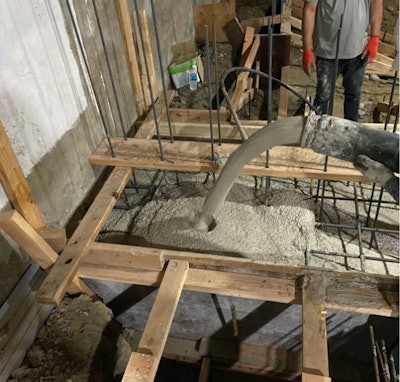
A company that says it has developed cement-free concrete recently got a nearly $1 million boost from the U.S. Department of Energy to expand development of the low-carbon alternative to Portland cement.
C-Crete Technologies, founded by MIT Professor Rouzbeh Savary, recently conducted its first pour of its cementless concrete for redeveloping a historic building in Seattle. Savary says the material could be used for any concrete infrastructure, including roads and bridges, and that the company is in discussions with some state departments of transportation about testing the product.
The concrete uses a binder of alternative, environmentally safe materials, according to C-Crete. The DOE grant will enable the company to research expanding the materials for its mixtures to those found in areas near construction projects. Doing so could eliminate the need for long-distance shipping and further reduce the carbon emissions involved in making concrete.
Savary says those local materials would be converted to cementitious binders. "In this way, architects, general contractors, local ready-mix companies and end users can simply utilize local feedstocks and materials in their construction projects, accelerating the move towards net zero emissions in construction."
C-Crete says its product creates almost no carbon dioxide during its production “and actually absorbs CO2 from the air over time.”
“Ordinary Portland cement accounts for about 8 percent of the total CO2 emissions worldwide,” the company says. “Each ton of C-Crete's cement-free binder used instead would eliminate around 1 ton of CO2 emissions.”
The cement-free concrete made its public debut in July when about 60 tons were poured for the foundation and shear walls for a seismic retrofit and energy upgrade project for a 111-year-old building in Seattle. Heidelberg Materials delivered the cement-free concrete for the project. To watch the pour, check out the C-Crete video below:
C-Crete reports that the concrete for the building had a loading strength of more than 5,000 pounds per square inch, which is higher than the 4,000 psi ASTM standard for most infrastructure projects. “It also meets other key industry standards, shows outstanding durability – such as resistance to freeze-thaw cycles, alkali-silica reactions, and chloride and acid penetrations – and is compatible with conventional concrete admixtures, allowing for easy integration into existing construction practices.”
The company also says its product achieves “cost parity” with conventional concrete. It is now looking to expand and accelerate the products’ usage by collaborating with architects, designers, general contractors, ready-mix companies, building owners and decision-makers for infrastructure projects.
“Given that our product meets industry standards and has cost-parity with conventional concrete, it opens up an entirely new era in construction,” Savary says.











